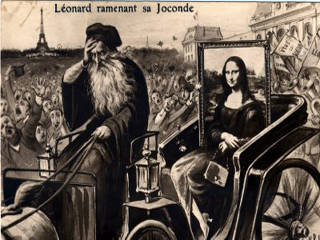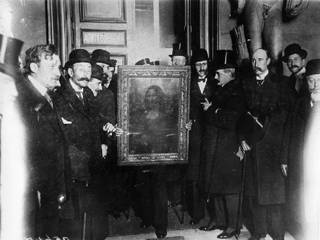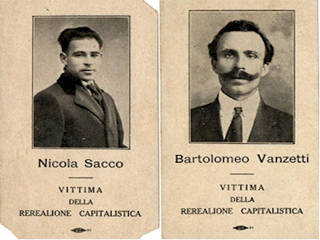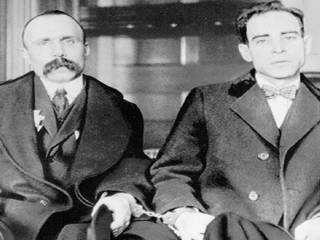Remembering the Mona Lisa Theft and Sacco and Vanzetti
This week, history celebrates the anniversaries of two international events that see Italian citizens as their main characters.
One hundred years ago, an Italian handyman named Vincenzo Peruggia stole the world's most famous painting, the Mona Lisa, from the world's most famous museum, the Louvre. On a day when the museum was closed for cleaning on August 20, 1911, Peruggia, originally from Dumenza, a town north of Milan near the shores of picturesque Lago Maggiore, walked in wearing a white smock to look like part of the cleaning crew then hid. He later slipped out of a closet inside the museum in which he had hidden overnight, removed the Mona Lisa from the wall and retreated to a service staircase.
“There he removed Leonardo da Vinci's renowned painting from its frame, wrapped it in a white sheet and descended the stairs,” Noah Charney of the Los Angeles Times writes, “But when he reached the bottom of the stairs, he found the exit locked. He unscrewed the doorknob, but the door still would not open. Peruggia had to wait for a passing plumber to let him out. Peruggia left the Louvre and disappeared into the streets of early morning Paris. It was recovered more than two years later when Peruggia tried to sell the painting to an antiques dealer in Florence in December 1913. He was tried in Italy but received a relatively light sentence and said he had acted purely out of patriotism.”
Supposedly, when police arrived to search Peruggia's apartment and question him, they accepted his alibi that he had been working at a different location on the day of the theft and he was not captured.
Officially, the reason behind the theft was that “the Italian immigrant, who had worked at the Louvre for a while installing protective glass over the paintings, had read that Napoleon looted art works throughout Europe and brought them back to France,” TIME Magazine reports, “This led him to think all the Italian works in the Louvre were there illegally. Peruggia decided to steal one of them and triumphantly return it to Italy, expecting this would bring him a reward from the Italian government.”
A new documentary, The Missing Piece, directed by Joe Medeiros releases evidence that Peruggia did not do it at all for fanatic patriotism: letters to his parents and a report by a court-appointed psychiatrist have no mention of duty to his country; instead, he spoke of using it to make his fortune. Meanwhile international headlines talk of this anniversary and mostly of a show featured in the thief's hometown.
“We believe Peruggia was a patriot,” said Simone Toffanin, director of the play entitled “The Trial of Vincenzo Peruggia” – part of a summer theater festival in Dumenza. While the mayor, Corrado Nazario Moro, thinks differently and does not want Peruggia to become some kind of local hero: “We do not want to become known as the birthplace of the Mona Lisa thief,” he said.
There are several citizens in Dumenza whose last name is Peruggia, but if they are related to Vincenzo nobody knows. His only daughter, Celestina, whose nickname was Giocondina (In Italian the Mona Lisa is called Gioconda, and Giocondina means “Little Gioconda”), died this past March. In an interview featured in the Italian press years ago and available on the town's web site, she said “My dad did not do the right thing by stealing the Mona Lisa, but his motivation was not totally wrong.” Joe Medeiros's opinion is different but Vincenzo was the one and only who knew the whole truth.
This week's second anniversary, is definitely more somber. On Aug. 23, 1927, Italian-born anarchists Nicola Sacco and Bartolomeo Vanzetti were executed in Boston for the murders of two men, Frederick Parmenter, a paymaster, and Alessandro Berardelli, a security guard, during a 1920 robbery. Although originally not under suspicion, both men were carrying guns along with anarchist literature at the time of their arrest and when questioned by the authorities they lied.
There was a highly politicized dispute over their guilt or innocence, as well as whether or not the trials they underwent were fair. The dispute focuses on small details and contradictory evidence. There was even a confession: in November 1925, Celestino Madeiros, an ex-convict awaiting trial for murder, confessed to committing the Braintree crimes and as a result, historians have not reached a consensus.
A New York Times article about the execution reported, “To the last they protested their innocence, and the efforts of many who believed them guiltless proved futile, although they fought a legal and extra legal battle unprecedented in the history of American jurisprudence.”
In 1977, as the 50th anniversary of the executions approached, Massachusetts Governor Michael Dukakis declared August 23, Nicola Sacco and Bartolomeo Vanzetti Memorial Day. His proclamation, issued in English and Italian, stated that Sacco and Vanzetti had been unfairly tried and convicted and that “any disgrace should be forever removed from their names.”






































i-Italy
Facebook
Google+
This work may not be reproduced, in whole or in part, without prior written permission.
Questo lavoro non può essere riprodotto, in tutto o in parte, senza permesso scritto.